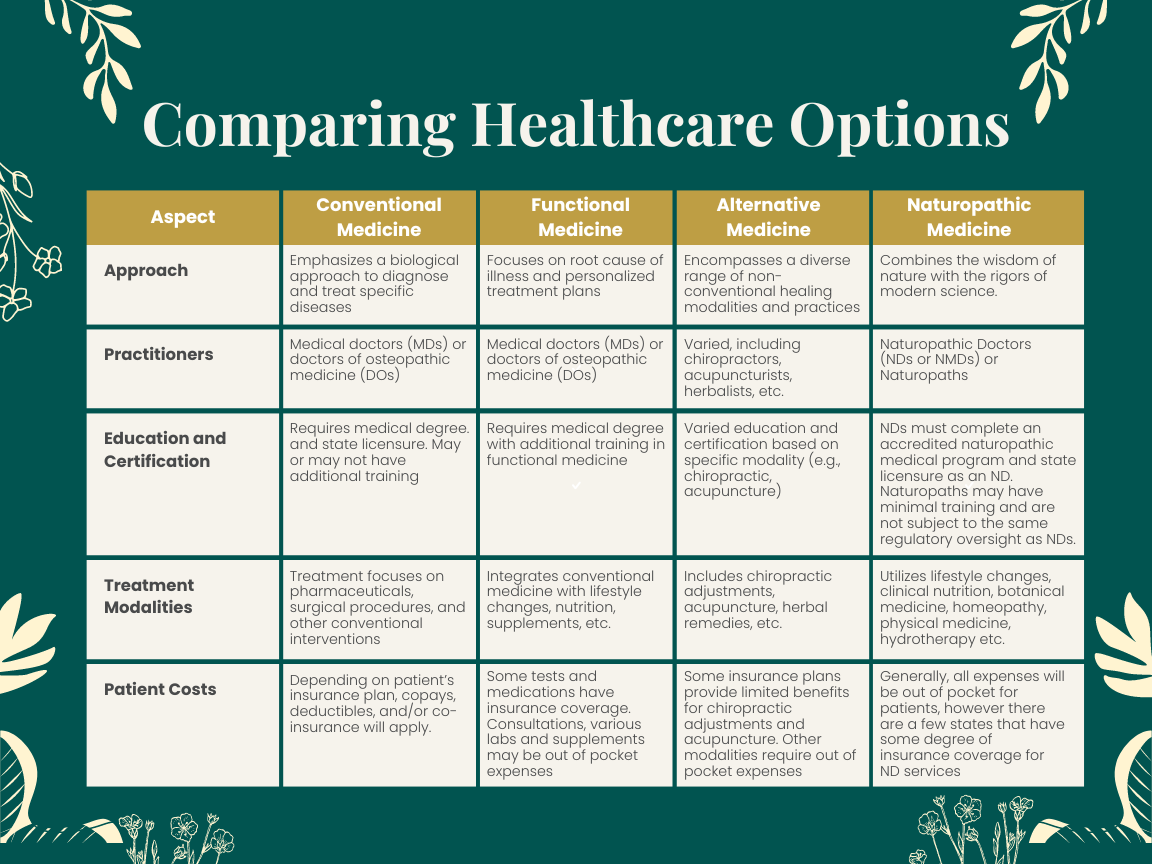Decoding Holistic Healthcare: Functional, Alternative and Naturopathic Medicine
Dr. Karen Plymel
Comparing Conventional, Functional, Alternative, and Naturopathic Healing

Beyond the confines of traditional healthcare is a vibrant world of integrative wellness. Are you ready to unlock the secrets of functional medicine, alternative therapies, and naturopathic care? As each of these has its own philosophy, methods and modalities, understanding the difference between them is essential for anyone seeking to achieve greater control in their own healthcare.
From uncovering the root causes of illness to exploring natural healing modalities, this exploration promises to revolutionize your approach to health. So, buckle up and prepare to decode the intricate tapestry of integrative healthcare – your path to optimal vitality awaits!
I. Conventional Medicine
Conventional medicine, also known as allopathic, traditional or mainstream medicine, is the prevailing healthcare option in most parts of the world. This approach is characterized by its emphasis on diagnosing and treating specific symptoms or diseases using pharmaceutical drugs, surgical procedures, and other conventional interventions and modalities. While conventional medicine has made significant advancements in treating acute conditions and emergencies, it can fall short when it comes to addressing chronic illnesses and promoting long-term wellness.
Key Considerations with Conventional Medicine
Symptom Management: Conventional medicine primarily focuses on managing symptoms rather than addressing the underlying root cause of illness. This approach often involves the use of medications to alleviate discomfort temporarily. When medications are used to suppress symptoms without addressing the underlying cause, patients may find themselves reliant on these medications for life. Discontinuing the medication could result in a return of symptoms, highlighting the temporary nature of symptom management without addressing the root cause. This reliance on pharmaceutical intervention for symptom management can perpetuate a cycle where patients are prescribed medications indefinitely, potentially leading to concerns about long-term side effects and diminishing efficacy over time.
Practitioners: Physicians in conventional medicine are medical doctors (MDs) of osteopathic medicine (DOs). Specialists will have additional training in their area of specialization, which varies by specialty. Patients typically seek care from a primary care physician (PCP) for general health concerns, annual check-ups, and common ailments like colds and viruses. However, if a patient presents with symptoms that cannot be easily diagnosed or managed, they may be referred to different specialists for further evaluation and treatment.
Fragmented Approach: Unlike holistic approaches such as functional medicine and naturopathic medicine, conventional medicine tends to view the body as a collection of separate systems or organs rather than as a unified whole. This fragmented approach may result in patients receiving care from multiple specialists, each focusing on a specific area of expertise, without considering the interconnectedness of various bodily functions.
Let's consider a patient who experiences persistent symptoms such as fatigue, joint pain, and gastrointestinal disturbances. After consulting with their PCP and undergoing initial testing, no definitive diagnosis is reached. In such cases, the patient may be referred to various specialists, including rheumatologists, gastroenterologists, and endocrinologists, to investigate different aspects of their health. This process of referral to specialist after specialist illustrates the fragmented nature of conventional medicine and the challenges patients may encounter in obtaining a comprehensive diagnosis and treatment plan.
While conventional medicine plays a crucial role in acute care and emergency situations, its limitations in addressing chronic conditions and promoting holistic wellness have led many individuals to explore alternative approaches such as functional medicine, naturopathic medicine, and other complementary therapies. By understanding the strengths and weaknesses of each approach, patients can make informed decisions about their healthcare and pursue paths that align with their values and health goals.
II. Functional Medicine
Functional medicine is a holistic approach to healthcare that combines conventional medicine with alternative therapeutic modalities to focus on identifying and addressing the root cause of illness rather than simply treating symptoms. Unlike traditional medicine, which often aims to manage symptoms and disease with medications, functional medicine seeks to understand the underlying imbalances or dysfunctions in the body that contribute to disease.
Key Considerations with Functional Medicine
Root Cause Approach: Functional medicine practitioners delve deep into a patient's medical history, lifestyle factors, genetics, and environmental influences to uncover the root cause of their health issues. By addressing the underlying imbalances, functional medicine aims to restore optimal function and promote long-term health and wellness.
Practitioners: Functional medicine practitioners are typically medical doctors (MDs) or doctors of osteopathic medicine (DOs) who have undergone additional training in functional medicine principles. They may work in various healthcare settings, including private practices, integrative medicine clinics, or functional medicine centers.
Education and Certifications: To practice functional medicine, healthcare providers must first obtain a medical degree (MD or DO) from an accredited medical school. Additionally, they may pursue further training and certification in functional medicine through recognized programs or institutions. Board certification in functional medicine demonstrates a practitioner's credibility and commitment to this field of medicine.
Functional medicine offers a patient centered approach to healthcare, focusing on individualized treatment plans tailored to each patient's unique needs and circumstances. By addressing the root cause of illness and promoting holistic wellness, functional medicine empowers patients to take an active role in their health journey and achieve optimal vitality and well-being.
III. Alternative Medicine
Alternative medicine encompasses a diverse range of non-conventional healing modalities and practices that often diverge from mainstream medical approaches. These modalities may include chiropractic care, acupuncture, herbal medicine, Ayurveda, and traditional Chinese medicine, among others. Alternative medicine approaches aim to promote health and wellness through natural means and may focus on holistic healing of the mind, body, and spirit.
Key Considerations with Alternative Medicine
Diverse Modalities: Alternative medicine encompasses a wide array of healing practices, each with its own unique philosophy and techniques. Examples include chiropractic care, which emphasizes spinal alignment and nervous system function, and acupuncture, which involves the insertion of thin needles into specific points on the body to promote balance and alleviate pain.
Practitioners: Practitioners of alternative medicine may come from various backgrounds and disciplines.
Chiropractors are licensed healthcare professionals who specialize in diagnosing and treating musculoskeletal disorders, primarily through manual adjustments of the spine and joints.
Acupuncturists are trained in the practice of acupuncture, a key component of traditional Chinese medicine aimed at restoring the flow of energy (qi) through the body's meridian pathways.
Education and Certifications: Alternative medicine practitioners typically undergo specific education and training in their respective modalities. Chiropractors must complete a Doctor of Chiropractic (DC) program from an accredited institution and obtain licensure in their state. Acupuncturists may pursue training through accredited acupuncture schools or programs and may be required to obtain certification or licensure, depending on state regulations.
Alternative medicine approaches often emphasize natural healing modalities, lifestyle modifications, and preventive care to support overall health and well-being. While they may be used as complementary therapies alongside conventional medical treatments, it's essential to consult with qualified healthcare providers and consider individual health needs and preferences when exploring alternative medicine options.
IV. Naturopathic Medicine
Naturopathic medicine embodies a holistic approach to healthcare, centered on the belief in the body's innate ability to heal itself when given the proper support. Naturopathic doctors (NDs or NMDs) prioritize treating the whole person, addressing underlying causes of illness, and fostering preventive measures to sustain long-term wellness. This discipline blends modern scientific knowledge with traditional and natural healing methods, advocating for patient empowerment and education.
Key Considerations with Naturopathic Medicine
Holistic Principles: Rooted in six guiding principles, naturopathic medicine emphasizes the healing power of nature, identification and treatment of the root cause of disease, and proactive health promotion through education. This approach recognizes the interconnection between the physical, mental, and spiritual aspects of an individual's well-being, underlining the importance of comprehensive care.
Practitioners: Naturopathic doctors (NDs or NMDs) are licensed healthcare professionals who undergo extensive education and training in naturopathic medicine. They conduct thorough assessments, integrating detailed medical histories, physical examinations, and laboratory analyses to formulate tailored treatment plans suited to each patient's needs. In some regulated states, NDs can serve as primary care physicians and can diagnose and prescribe medications. Traditional naturopaths, on the other hand, may not diagnose or treat disease or illness, but are able to serve as a health consultant or coach.
Education and Certification: It's important to differentiate between licensed naturopathic doctors (NDs/NMDs) and traditional naturopaths (sometimes called “health coaches”). Naturopathic doctors (NDs/NMDs) complete rigorous four-year postgraduate programs at a naturopathic medical school accredited by the
Council on Naturopathic Medical Education (CNME), which is the only recognized accrediting body for naturopathic medical programs in the US and Canada. Currently there are only 5 accredited programs in North America. Their training encompasses comprehensive coursework in basic and clinical sciences, diagnostics, and natural therapeutics. Following graduation, NDs must pass licensing exams administered by state regulatory boards to practice naturopathic medicine legally. Some NDs may opt to complete a post-doctoral residency at a healthcare facility.
In contrast, the education requirements for a traditional naturopath are not standardized and the programs are not recognized or accredited. There are a variety of online and correspondence programs in which students can receive a certification in naturopathy. These programs do not have standardized curriculum and can vary in length from weeks to months (or longer, depending on the student’s speed of self-study). In addition, traditional naturopaths are not eligible for state licensure and as such, many graduates of these non-accredited programs elect to practice in unregulated regions.
State-Specific Regulations:
Regulations regarding the practice of naturopathic medicine vary from state to state, leading to differing requirements and scopes of practice. To add to the confusion, some traditional naturopaths may opt to use the title “naturopathic doctor” if they are practicing in an unregulated state. If you are considering naturopathy as an option, it’s important to understand whether your
state has licensing requirements and
verify your practitioner’s qualifications.
Naturopathic medicine offers a diverse range of natural treatment modalities, including clinical nutrition, botanical medicine, homeopathy, hydrotherapy, and lifestyle counseling. By prioritizing individualized care, preventive strategies, and the promotion of overall well-being, naturopathic doctors play a vital role in supporting patients on their journey towards optimal health and vitality.
V. Understanding the Difference between Healthcare Options
In understanding the landscape of healthcare options, it's essential to compare and contrast the key features of functional medicine, alternative medicine, and naturopathic medicine. While all three approaches share a commitment to holistic wellness and personalized care, they differ in their underlying philosophies, practitioners, treatment modalities, and associated costs.
Conclusion
As we navigate the diverse landscape of healthcare options, understanding the nuances between conventional medicine, functional medicine, alternative medicine, and naturopathic medicine empowers us to make informed decisions about our well-being. Whether seeking the expertise of a functional medicine physician to uncover underlying health imbalances, exploring alternative modalities like acupuncture or chiropractic care, or embracing the natural approach of naturopathic medicine, each path offers unique benefits and considerations tailored to individual needs.
Top 5 FAQs:
1. What is the main difference between functional medicine and alternative medicine?
Functional medicine focuses on identifying and addressing the root cause of illness, often practiced by medical doctors. Alternative medicine encompasses various non-conventional healing modalities, such as chiropractic care and acupuncture, provided by practitioners like chiropractors and acupuncturists.
2. Are naturopathic doctors (NDs or NMDs) considered medical doctors?
Naturopathic doctors (NDs) are not medical doctors (MDs), however, they undergo extensive training in accredited naturopathic medical programs that include 4 years of postgraduate study as well as clinical rotations. They are licensed healthcare providers and as such must adhere to regulations. Learn more about the difference between NDs and MDs/DOs.
3. Do practitioners of alternative medicine require specific certifications?
Yes, practitioners of alternative medicine, such as chiropractors and acupuncturists, typically require specific education, training, and certification to practice legally.
4. Can I combine different approaches like functional medicine and naturopathic medicine?
Absolutely! Many individuals choose to integrate multiple approaches to healthcare, such as combining functional medicine principles with naturopathic modalities, under the guidance of qualified healthcare providers.
5. How do I know which approach is best for my health needs?
The best approach depends on various factors, including your specific health concerns, preferences, and values. Consulting with qualified practitioners and discussing your individual needs can help you determine the most suitable approach for your healthcare journey.
Which aspect of functional medicine, alternative medicine, or naturopathic medicine resonates most with your health goals and values? We'd love to hear your thoughts and experiences in the comments below!



Copyright © 2019 Elevate Health. All Rights Reserved.




